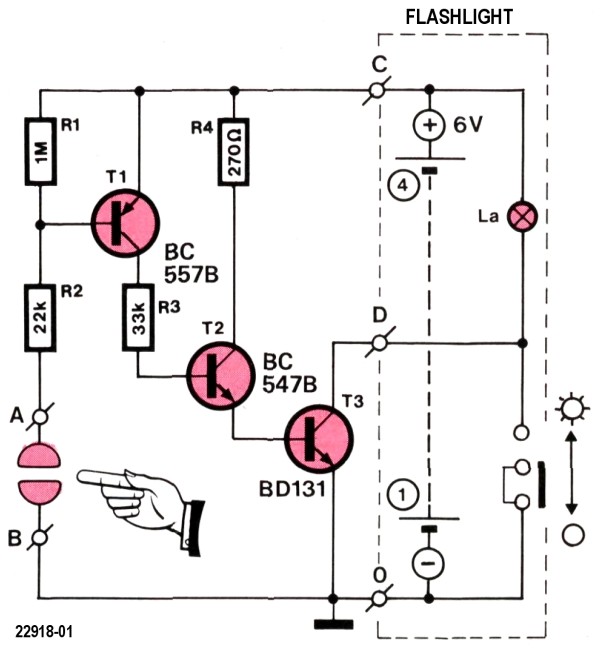Small Circuits Revival (40): Automatic Flashlight
on
Automatic Flashlight
Idea: Elektor Labs
Having to look for a flashlight in the dark is already unpleasant (during the day, you see it lying there, but you don't need it), but then to make things worse, you have to fumble around to find the switch. A much nicer option is a flashlight that immediately turns on the moment you pick it up, and that is exactly what the circuit in Figure 1 takes care of.

The circuit is very simple. As a "grab detector," we use a homemade "touch button" between points A and B in the schematic. As long as the circuit is at rest (touch button not touched), transistor T1's base and emitter carry an equal potential: the transistor is held off and consequently T2 and T3 will also be held off.
That changes as soon as we pick up the flashlight and bridge contacts A and B with our skin's resistance. A small current then flows through R1 and R2, with the result that the base of T1 becomes slightly more negative than its emitter: the transistor starts conducting. (Note that only the voltage difference between base and emitter matters here!) Via T1, T2 and T3 now receive a base current: they will also conduct and the flashlight will illuminate.
T2 and T3 form a kind of discrete Darlington, except that the two collectors are not connected to each other as in a real Darlington circuit. This was done to keep the voltage drop across T3 as low as possible.
That's the long and short of it.The electronics can easily be built up "in the air" or on a piece of perfboard and built in somewhere in the flashlight. As for the touch switch between points A and B, it can be made from a few (four or six) strips of single-sided printed circuit board that are glued against the outside of the flashlight and connected alternately to points A and B.
A final note: the flashlight's (slide) switch will continue to function, as indicated in the bottom right of the diagram. This way, the flashlight can stay on even if we put it away somewhere.


Discussion (0 comments)